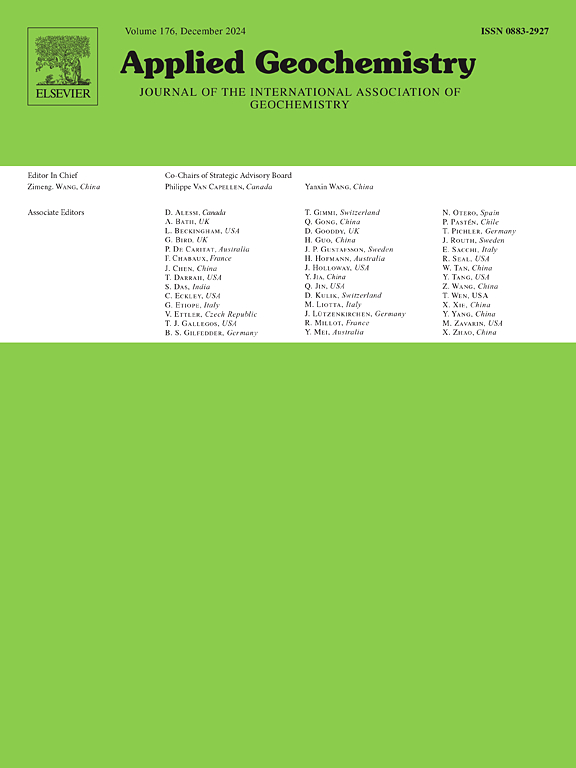Occurrence and provenance of ion-adsorbed rare earth elements mineralization in alumina-rich rocks of the Permian Heshan formation, Western Guangxi, China
IF 3.4
3区 地球科学
Q1 GEOCHEMISTRY & GEOPHYSICS
引用次数: 0
Abstract
The enrichment of rare earth elements (REEs) in alumina-rich rocks (ARR) is widely observed. However, REEs in ARR are primarily present in mineral forms, which poses significant challenges to their practical utilization. Recently, the Permian Heshan Formation in Shangsi County, western Guangxi, China, has attracted attention due to the discovery of an unusual occurrence of ion-adsorbed REEs mineralization within ARR. In this study, four ARR samples and an underlying limestone were collected from a single geological profile to investigate the occurrence of REEs through chemical sequential extraction, scanning electron microscopy (SEM), X-ray diffraction (XRD). Furthermore, the provenance of REEs was analyzed based on U–Pb geochronology and chemical compositions in detrital zircons. The results show that REEs content in four ARR ranges from 897 to 2753 ppm, with an average of 1507 ppm, exceeding the industrial grade (1000 ppm) for ion-adsorbed REEs deposits. Notably, the ion-exchangeable phase (F2, average 58.97 %) constitutes the dominant REEs fraction, followed by the residual phase (F7, average 17.98 %), Fe–Mn oxide phase (F5, average 7.01 %), humic acid phase (F4, average 5.58 %), organic-matter phase (F6, average 5.50 %), water soluble phase (F1, average 3.19 %), and carbonate-bound phase (F3, average 0.52 %). Moreover, distinct REEs fractionation patterns are evident across different phases. Light REEs (LREEs) are predominantly adsorbed by clay minerals, whereas heavy REEs (HREEs) primarily retained in the residual phase. The morphology and U–Pb geochronology of detrital zircons provide evidence that the provenance of REEs underwent a significant change from the bottom to the top of the stratigraphic profile. Additionally, mineralogical compositions, chondrite-normalized REE patterns, and zircon geochemical characteristics further support that the variation in REE sources within the profile. Geochemical plots and tectonic discrimination diagrams suggest that REEs in the upper section of the profile primarily originated from the Permian Paleo-Tethys magmatic arc, whereas the lower section predominantly inherited its REEs from the underlying limestone. The introduction of foreign acidic magmatic materials is presumed to have contributed to the formation of the ion-adsorbed REEs enrichment zone within the ARR of the Heshan Formation. The present study contributes to an enhanced and more comprehensive understanding of the mechanism governing REEs enrichment in paleo-weathered horizons.
桂西二叠系鹤山组富铝岩中离子吸附稀土元素矿化的赋存状态及物源
稀土元素在富铝岩(ARR)中的富集被广泛观察。然而,ARR中的稀土元素主要以矿物形式存在,这对其实际利用构成了重大挑战。近年来,广西西部上寺县二叠系鹤山组在ARR内发现了一种罕见的离子吸附稀土矿化,引起了人们的关注。通过化学序列萃取、扫描电镜(SEM)、x射线衍射(XRD)等方法,对同一地质剖面的4个ARR样品和下伏石灰岩进行了稀土元素赋存状态的研究。根据碎屑锆石的U-Pb年代学和化学成分分析了稀土元素的来源。结果表明,4个ARR中稀土元素含量在897 ~ 2753 ppm之间,平均为1507 ppm,超过了离子吸附稀土矿床的工业级(1000 ppm)。稀土元素的主要组分为离子交换相(F2,平均58.97%),其次为残余相(F7,平均17.98%)、Fe-Mn氧化物相(F5,平均7.01%)、腐植酸相(F4,平均5.58%)、有机质相(F6,平均5.50%)、水溶性相(F1,平均3.19%)和碳酸盐结合相(F3,平均0.52%)。此外,稀土元素在不同阶段的分馏模式明显不同。轻稀土(lree)主要被粘土矿物吸附,而重稀土(hree)主要保留在残余相中。碎屑锆石的形态和U-Pb年代学表明,从地层剖面的底部到顶部,稀土元素的来源发生了明显的变化。此外,矿物组成、球粒陨石归一化稀土模式和锆石地球化学特征进一步支持了剖面内稀土来源的变化。地球化学图和构造判别图表明,剖面上剖面的稀土元素主要来源于二叠纪古特提斯岩浆弧,而剖面下剖面的稀土元素主要继承于下伏灰岩。外来酸性岩浆物质的引入对河山组ARR内离子吸附稀土富集带的形成有一定的促进作用。本研究有助于加强和更全面地了解古风化层稀土富集的机制。
本文章由计算机程序翻译,如有差异,请以英文原文为准。
求助全文
约1分钟内获得全文
求助全文
来源期刊

Applied Geochemistry
地学-地球化学与地球物理
CiteScore
6.10
自引率
8.80%
发文量
272
审稿时长
65 days
期刊介绍:
Applied Geochemistry is an international journal devoted to publication of original research papers, rapid research communications and selected review papers in geochemistry and urban geochemistry which have some practical application to an aspect of human endeavour, such as the preservation of the environment, health, waste disposal and the search for resources. Papers on applications of inorganic, organic and isotope geochemistry and geochemical processes are therefore welcome provided they meet the main criterion. Spatial and temporal monitoring case studies are only of interest to our international readership if they present new ideas of broad application.
Topics covered include: (1) Environmental geochemistry (including natural and anthropogenic aspects, and protection and remediation strategies); (2) Hydrogeochemistry (surface and groundwater); (3) Medical (urban) geochemistry; (4) The search for energy resources (in particular unconventional oil and gas or emerging metal resources); (5) Energy exploitation (in particular geothermal energy and CCS); (6) Upgrading of energy and mineral resources where there is a direct geochemical application; and (7) Waste disposal, including nuclear waste disposal.
 求助内容:
求助内容: 应助结果提醒方式:
应助结果提醒方式:


